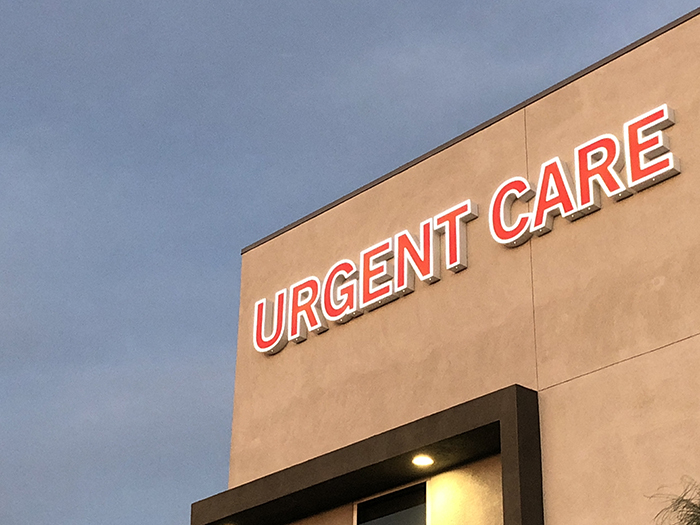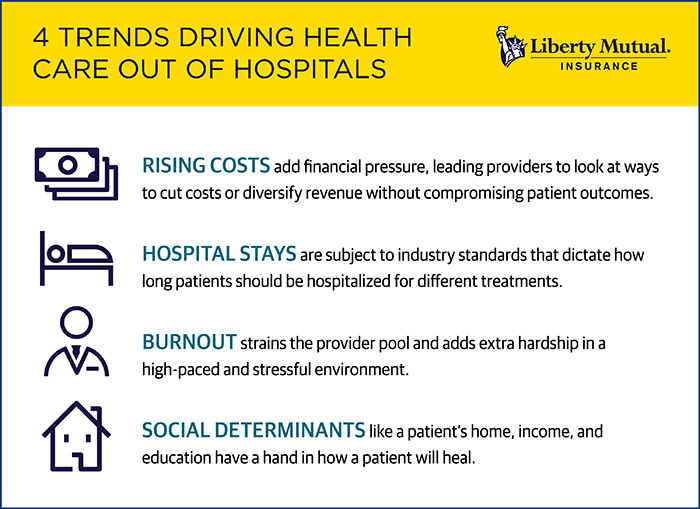Sponsored: Liberty Mutual Insurance
Alternative Health Care Delivery Methods Are Increasing in Use — Risk Managers Beware

Health care is an ever-changing industry, adapting to both the needs of its patients as well as the demands of its partners.
“We are seeing payers pressuring providers because of the rising costs of health care,” explained Jeff Duncan, chief underwriting officer, Healthcare Practice, Liberty Mutual.
This financial pressure has providers looking for ways to cut costs or diversify revenue without compromising patient care or outcomes. One solution some have invested in is limiting hospital stays. Standards for how long patients should be hospitalized for different treatments are being implemented to prevent longer, unnecessary stays where the chances of infection or other complications increase.
Outcomes, however, are still heavily influenced by the social determinants of health — the socioeconomic factors that impact a patient’s recovery, like poverty, education gaps, lifestyle choices and more. This strains hospitals’ resources while limiting their control over the cost of care.
“These factors can drive massive costs throughout the entire health care system,” explained Duncan.
And providers are feeling the strain: “There’s a shortage of qualified nurses and physicians in some areas, while others face serious burnout rates,” said Njoki Wamiti, VP & miscellaneous medical facilities product manager, Ironshore.
“Risk managers are caught in the middle of this in both fulfilling the missions of their organizations, protecting balance sheets and protecting patients and employees,” Duncan said.
To best serve their communities, health care systems are investing in ways to make treatment more accessible and affordable for patients. Here are two alternative methods finding a place in the health care system.
1) Urgent care clinics have become the hub for servicing low acute medical needs.

Jeff Duncan, Chief Underwriting Officer, Healthcare Practice, Liberty Mutual
Acting as an in-between for emergency departments (ED) and primary care physicians, urgent care “is meeting the needs of people who may not have an emergency, but who also cannot wait weeks for an appointment with their family doctor,” said Duncan.
Thanks to increased use of urgent care, low acuity cases can be seen in a timely manner for a reasonable price.
“They’re taking quite a bit of burden off the emergency department, as well,” said Duncan. With more people utilizing urgent care, ED personnel can devote more of their time and focus to the patients who come in with critical or traumatic care needs, he explained.
“It’s also creating an alternative revenue stream for health care systems that invest in urgent care.”
Primary care physicians see the same financial benefit, as well as relief from potential burnout. Instead of facing a waiting room of 30+ patients and strict time constraints, physicians can spend more time with the patients under their care.
“Urgent care also fulfills that need for areas where they don’t have as many primary care physicians practicing within their location,” Wamiti added.
What Risk Management Needs to Know: The risk environment within an urgent care clinic is much like that of a hospital. It is a facility providing care to patients, and therefore should be held to the same standard as hospitals.
Reviewing licensure and credentialing of staff is paramount. Making sure employees as well as the facility’s vendors and partners meet requirements should be of utmost importance in maintaining the upkeep at an urgent care facility.
However, “it’s important to note that an urgent care facility is not an emergency department,” said Wamiti. “That’s our number one concern from an insurance standpoint.”
Urgent care facilities are licensed similarly to ambulatory care. That means if a patient comes in with emergency conditions — such as a stroke, heart attack or severe bleeding — it is imperative for the physicians and other medical staff to know when to call the ED.
Data privacy also remains high on the list of risks to watch.
“Patients could be receiving treatments in different venues and with different partners in a health care network,” said Wamiti. “With HIPAA and other privacy standards at play, data security remains vital.”
2) Home health providers, while not new to the health care realm, have significantly evolved since first inception.

Njoki Wamiti, VP & Miscellaneous Medical Facilities Product Manager, Ironshore
“More injuries and illnesses can be treated in the home setting thanks to technology and medical advancement,” said Wamiti. Plus, the same standard of care is being provided in the comforts of a patient’s home, she said.
Physical, occupational and respiratory therapies can be a part of a patient’s home health care plan, as well as intravenous methods of treatment. Technologies like telemedicine and wearable devices aid in monitoring heart rate, blood pressure and glucose levels. Seeing a patient in their home enables providers to see how environment impacts healing.
“When home health agencies are owned or affiliated with a hospital, the hospital knows patients are getting the care they need, and revenue from home health is still coming back into the hospital,” said Wamiti.
What Risk Management Needs to Know: “With home health,” said Duncan, “it’s about managing trade-offs.”
On the one hand, cost of care is lowered and demand for in-hospital beds goes down. On the other, employees are being introduced into the unknown: a patient’s home.
“Hospital risk managers need to invest in training for their off-site employees. What makes the home setting different than a hospital? What should they be doing to adapt to the environment?” Duncan said. “Training should look at those questions.”
Additionally, rules for the road need to be implemented. With more providers driving to and from patients’ homes, the added risk of accident increases liability and workers compensation concerns.
Other concerns, Wamiti and Duncan agreed, include reviewing wearable technologies at the home regularly, vetting employees and making sure licensures and credentials are up-to-date, reviewing and recording care plans, and sticking to protocol.
“Sometimes family members rooted in the care of an individual might pressure providers to go outside of protocol,” said Duncan. “Whether that be because they don’t understand why a certain care method is needed or they have done things differently in the past.”
It’s important, then, for employees to adhere to care plans while in the home.

Working with the Risk Management Team to Promote Better Care
Delivering better patient care starts with having a risk management team that is invested in the outcome.
Liberty Mutual works with a hospital’s risk management team to get the information, coverage and support they need.
“We write for large hospital systems, large health care systems, and everything that falls under that umbrella,” said Wamiti. “That includes urgent care centers. We will write for the skilled care, physical therapy, and infusion therapy in the home.”
“There are plenty of insurance companies that take a very narrow view of the risks they want to write,” said Duncan. “But we believe that we get better outcomes when we put ourselves in the shoes of risk managers and are willing to take on the risks hospitals face.”
To learn more, visit https://business.libertymutualgroup.com/business-insurance/industries/health-care-providers-insurance-coverage.
![]()
This article was produced by the R&I Brand Studio, a unit of the advertising department of Risk & Insurance, in collaboration with Liberty Mutual Insurance. The editorial staff of Risk & Insurance had no role in its preparation.










